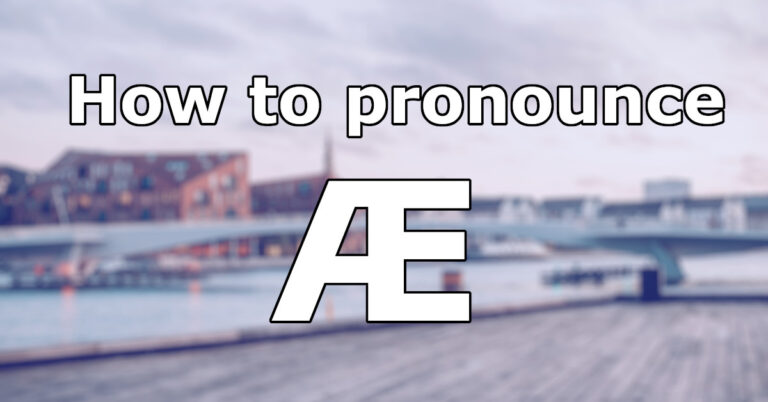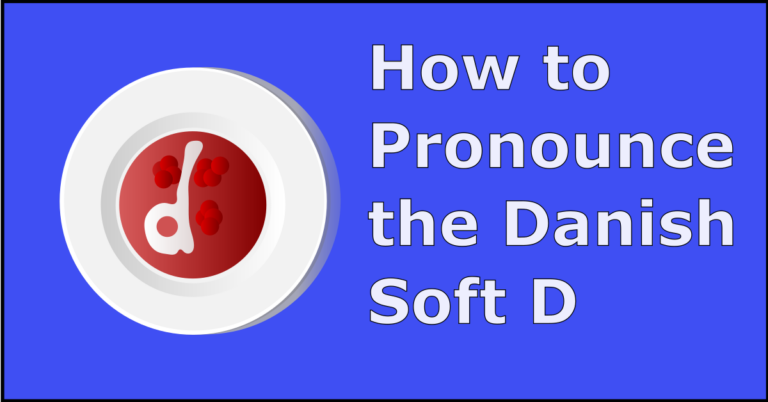A Complete Guide to the Danish Vowels

As you begin your Danish learning journey, you may find that all of the words kind of blend into each other, in what sounds like one long, messy vowel sound. This is because Danish has more vowel sounds than most languages. To the untrained ear, it can be difficult to distinguish between the different sounds, making it difficult for someone new to the language to understand it or speak clearly.
The good news is, with a bit of awareness of how different vowels are made, and conscious practise in reproducing the Danish vowels, it will quite quickly become a lot clearer, and all of a sudden you will be able to hear and understand what once sounded like a big mushy, vowelly mess.
A little bit of work on the Danish vowel sounds will go a long way – in fact, I am a firm believer that improving your pronunciation is one of the best ways to improve your Danish language skills in general.
How many vowels are there in Danish?
This is not as easy a question to answer as you might think. Of course, we have the 9 vowel letters of Danish – a, e, i, o, u, y, å, æ, ø – but there are a lot more vowel sounds. How many sounds depends on the speaker, and what you classify as a vowel sound (ie do you want to distinguish between long and short vowels, and vowels with stød, the Danish glottal stop). Because of this, Danish is reported as having anywhere between about 20 and 40 vowel sounds.
Can English speakers learn the Danish vowels?
In short, yes. Most accents of English have between 14 to 20 vowel sounds – still quite a lot compared to most languages. On top of this, the different accents of English have a great amount of variation in vowel sounds, meaning that English speakers are used to hearing an even wider variety of vowel sounds, putting them in a good position to learn the vowels of Danish.
The vowel sounds that will likely cause the most problems are the rounded sounds (where the lips are rounded), but we have some of these sounds in English so all it takes is getting used to doing it in different contexts.
What is the best way to learn the Danish vowels?
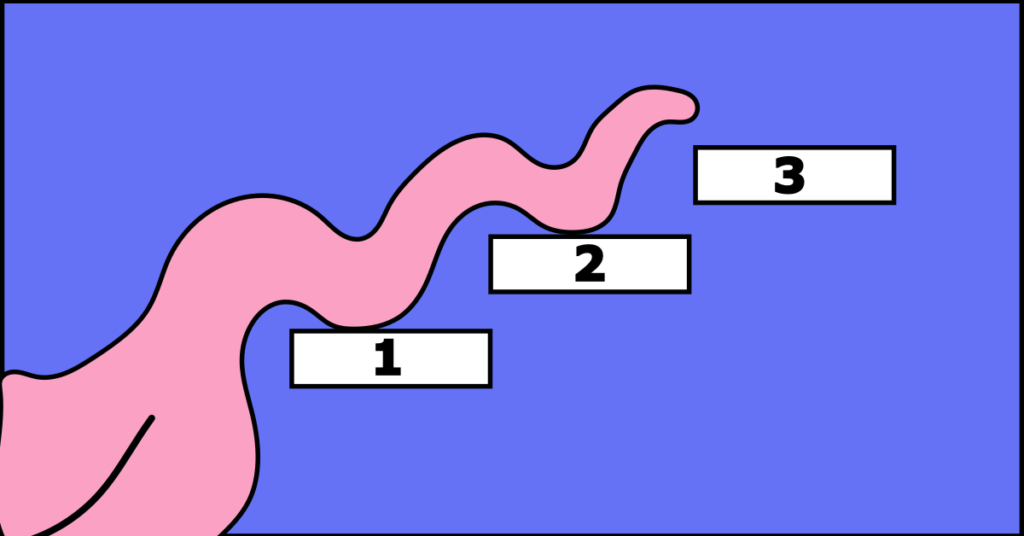
Breaking the process down into a few steps will make the process much easier.
- Learn how you make different vowels in English. Getting used to what your mouth does as you make different vowel sounds in English will provide you with a strong base from which to add in the new sounds.
- Split the Danish vowels into categories. It is much easier to understand and hear the different vowel sounds if you break them down into different categories. The main categories will be the front unrounded sounds (tongue at the front of the mouth, lips not rounded), the front rounded sounds (tongue at the front of the mouth, lips rounded), and the back sounds (tongue at the back of the mouth).
- Practise both speaking and listening to the sounds. Listen over and over again to the sounds in each category. Try to repeat the sounds. Listen to the sounds that are closest to each other and test your ability to tell the difference. Record yourself speaking the sounds and compare to a recording of a native speaker.
- Practise in different contexts. Once you are comfortable with the different sounds, try practising them in different letters on either side, and in different phrases and sentences.
The Danish front unrounded vowels
Front vowels are vowels made with your tongue at the front of your mouth (think of the ‘eeee’ (phonetically written as /i/) sound of the word ‘free’ in comparison with the ‘uuuu’ (/u/) of ‘shoe’).
Unrounded vowels are vowels in which your lips are not round, but are relaxed (think of how you almost smile as you say ‘free’).
The Danish front, unrounded sounds are i, e, ɛ, æ, a.
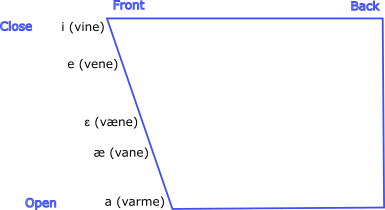
The i sound is the most closed sound. Your tongue is at the front of your mouth, and near the roof of your mouth. This is found in English words like ‘free’. Easy peasy.
The e sound is just a little bit more open than the i sound. That means that you lower your tongue a tiny bit. Another way to think of it is to open your mouth a bit. This is very similar to the i sound of the English word ‘bit’, although perhaps a tiny bit more open.
The ɛ sound is a little more open again. This is similar to the vowel at the start of the English ‘may’.
The æ sound is a little more open again, similar to the English ‘bed’.
The a sound is very open, similar to the English ‘hat’ (more open than the General American pronunciation).
As you can see, most of these sounds have a similar sound in English, so not the most difficult to get your mouth around. The difficulty comes in that some of the sounds are quite close together, so they can be difficult to tell apart at first.
A good way to practise is to use this website, and scroll down to the unrounded front vowels section. They have them listed with audio examples that you can use to copy and practise. On the left they have the longer vowel sounds, and on the right, the shorter sounds.
The Danish Front Rounded Vowels
The front rounded vowels are what you think of when you think of the sound of Danish. These are the ones that will be most different from English. The good news is, if you can make the unrounded sounds, all you need to do is round your lips to make the rounded sounds.
The front rounded sounds in Danish are y, ø, and œ.
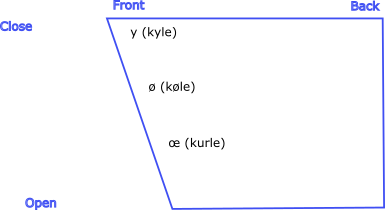
The y sound is made with the mouth in the exact same position as the i sound of ‘free’. Then you just need to round your lips into a pout. You can exaggerate this movement at first to really get the feel for it. This sound is present in some accents of English (such as the Northern Irish accent) in words like ‘few’.
The ø sound is a little more open than this, so the tongue lowers a bit in the mouth but the lips remain round. Another way to reach this sound is to take the i sound of the word ‘bit’ and then round the lips.
The œ sound is more open again. Again we can take the æ sound of the Danish ‘frisk’ and then round the lips. Some people may even use this sound in English, in pronouncing the French word ‘boeuf’.
The Danish Back Vowels
The back vowels are the sounds made when the tongue is pulled back in the mouth. These vowels tend to be made with rounded lips (both in English and Danish).
The back vowels in Danish are u, o, ɔ and ɒ.
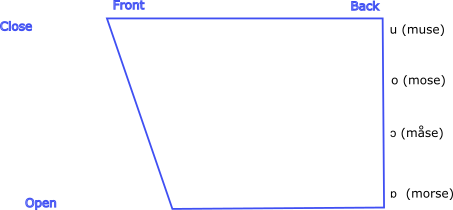
The u sound is a closed sound, so the tongue is near the top of the mouth – but unlike the i sound, it is pulled back in the mouth. This is the sound in the word ‘two’ in RP British English.
The o sound is a little more open,
The ɔ sound is more open again. This is similar to the ʌ sound found in the American pronunciation of ‘gut’, but with the lips rounded.
The ɒ sound is the most open – it is similar to the vowel sound in the British pronunciation of the word ‘sock’.
The back vowel sounds vary in different accents of English, so it is difficult to pinpoint similar words. The best approach here is to keep listening to, and trying to repeat the sounds. If you can get the most closed and the most open sounds accurate, them you can try out different sounds in between until you find the right one.
The Unstressed Vowels
Some vowels in Danish only appear on syllables that aren’t stressed. These vowels tend to be very relaxed and almost skipped over. This is similar to English. Take the word ‘fatal’ in English. The stress is on the first syllable and so the first ‘a’ is pronounced strongly, whereas the second a is replaced with a short, relaxed vowel sound (this vowel is called the schwa in English).
In Danish the main unstressed vowels are ə, ɐ
The ə sound is the same as the schwa in English – this is a very common sound in English – it sounds like a short ‘uh’ (try saying the word ‘salad’. The second ‘a’ is the schwa sound. We don’t often think about it in English, but you will notice that it is not actually and ‘a’ at all. This sound can replace all unstressed vowels – such as the ‘o’ in lemon).
The ɐ sound is a little more open. This is just a little bit more open than the schwa, and appears where there is an unstressed syllable with an ‘r’.
The Diphthongs
Diphthongs are when two vowel sounds come together to make one sound. Think of the English word ‘how’ and how the vowel sound changes.
The diphthongs in Danish are very similar to English and generally don’t cause a lot of confusion for English speakers.
They usually appear with a ‘v’ (which is similar to a ‘w’ in English – ‘hav’), with a ‘j’ (similar to an ‘i’ in English – ‘hej’), and an ‘r’ (similar to an ‘r’ in some British accents – ‘mor’).
Final Thoughts
The amount of Danish vowel sounds might seem overwhelming at first, but if you break it down into different categories it can be quite manageable and you can quickly get good at distinguishing and pronouncing the most important ones.
Generally, for English speakers, the unstressed vowels and diphthongs won’t cause too many difficulties, so you only need to focus on the strong vowel sounds.
After breaking them into categories, you can start by spending a bit of time practising the front unrounded vowels. These are fairly similar to English so it is just about getting used to them in a new context. You can then take the front rounded vowels. Once you get used to making rounded vowel sounds you will start to really develop the ability to deal with the difficult aspects of Danish pronunciation. Finally, work on the back sounds until you can repeat them.
Once you are capable of making the sounds, it is all about practise. Listen carefully to native speech and try to pick out the different sounds. Practise repeating the sounds over and over until they become second nature. Remember, you are training muscles in your mouth here, so you need to practise in order to build up your ability.

